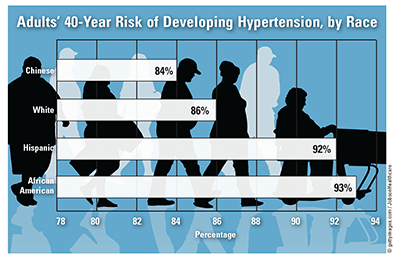US Pharm. 2018;43(2):10.
Hypertension, a chronic condition, affects 31% of U.S. adults. From 2013 to 2014, 40.3 million and 3.7 million visits, respectively, were made to physicians’ offices and hospital outpatient departments, and the primary diagnosis was essential hypertension. Essential hypertension and hypertensive renal disease claimed 30,221 lives (9.5 per 100,000 people). The prevalence of controlled hypertension was 53.0%, and adults aged 18 to 39 years were less likely than those aged 60 years and older to have controlled hypertension. From 1999 to 2014, hypertension prevalence was unchanged but control of hypertension increased, according to the CDC.

Prevalence of Hypertension: One in three adults was hypertensive and another 1 in 3 was prehypertensive, at a cost of $46 billion per year. Hypertension affected 86 million adults (33.5%), and primary (essential) and secondary hypertension accounted for 90% to 95% and 2% to 10% of cases, respectively. The probability of developing hypertension over a 40-year period varied (84%-93%) across ethnic groups (from Carson AP, Howard G, Burke GL, et al. Ethnic differences in hypertension incidence among middle-aged and older U. S. adults: the multi-ethnic study of atherosclerosis. Hypertension. 2010;57:1101-1107). Hypertensive men aged younger than 50 years outnumbered hypertensive women, but the relative proportionality reversed with age progression.
Uncontrolled Hypertension: This condition prevailed among 35.8 million adults, and uncontrolled hypertension was more prevalent in men (55%) than in women (52.1%). Except for persons aged 80 years and older (62.1%), age progression led to a decreasing prevalence of uncontrolled hypertension. Prevalence was highest in persons aged 18 to 44 years (61.6%), followed by those aged 45 to 64 years (51.1%) and 65 to 79 years (49.7%). Sixteen million adults (51.6% women) knew that they had uncontrolled hypertension and were being treated for it. One-third (5.7 million) did not get treated even after confirmation of their condition, and roughly 36% more women than men were aware of their condition and were treated. Lack of awareness of uncontrolled hypertension was 24.9% more prevalent in men (43.7%) than in women (35%). About 14 million adults were unaware that they had hypertension.
Hypertensive Emergencies: Hypertensive emergencies resulted in cerebral infarction (24%), pulmonary edema (23%), hypertensive encephalopathy (16%), and congestive heart failure (12%). However, the use of antihypertensive drugs significantly reduced the incidence from 7% to 1%. The current treatment protocol helped increase 1-year survival from 20% in 1950 to 90%, but related emergency department (ED) visits increased more than twofold between 2006 and 2013. During ED stays, between 3% and 45% of adults had at least one incident of hypertension.
To comment on this article, contact rdavidson@uspharmacist.com.






